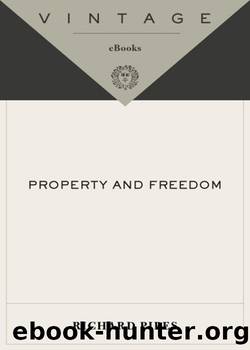Property and Freedom by Richard Pipes

Author:Richard Pipes [Pipes, Richard]
Language: eng
Format: epub
Tags: Economic Policy, Nonfiction, Political Economy, political science, History & Theory, Public Policy
ISBN: 9780307427359
Google: 098M3m4gP1kC
Publisher: Knopf Doubleday Publishing Group
Published: 2007-12-18T00:23:55.615530+00:00
4. The Russian city
The absence in tsarist Russia of property in land would have had fewer consequences for her political evolution had that country developed self-governing urban communities. The Western European city gave rise to three institutions: (1) absolute private property in the form of capital and urban real estate at a time when the principal productive asset, land, was held conditionally; (2) self-government and judiciary autonomy; and (3) common citizenship in the sense that all urban inhabitants were freemen who shared civil rights by virtue of residence in the city rather than their social status. It is, therefore, of considerable importance that in Russiaâwith the notable exception of Novgorod and Pskov, neither of which survived into the modern eraâ cities of this kind failed to emerge.
As noted previously, at the dawn of her history (tenth and eleventh centuries) Russia had numerous urban centers which did not significantly differ in either appearance or function from those of Western Europe two centuries earlier. They were citadels built to protect the Viking ruling elite and its goods, outside whose walls artisans set up their workshops and traders their stalls. Typically, the early Russian city consisted of two parts: the fortress or kreml, near which stood the cathedral, both structures protected by a palisade of wood or stone; and the commercial settlement outside the walls, called posad.
In Western Europe during the eleventh and twelfth centuries, such primitive fortress-towns began to evolve into something quite different. Benefiting from the revival of trade, the cities of Italy, Germany, and the Low Countries organized into communes, which acquired the right to govern themselves and to dispense justice to their citizens. Again, with the exception of Novgorod and Pskov, nothing comparable occurred in Russia. The reasons were both economic and political. At the very time when trade revived in Western Europe, it declined in central and southern Russia: the disruption of the âGreek Routeâ and the resultant concentration on agriculture significantly reduced the commercial role of the cities. Secondly, the Mongols, viewing cities as centers of resistance, eliminated their organs of self-rule. The princes of Moscow, first as agents of the Mongols and then as sovereigns in their own right, would not tolerate autonomous enclaves exempt from tribute, service, and tiaglo. The patrimonial principle applied to the entire realm, without exception. Thus, the cities of central Russia turned into military-administrative outposts distinguished neither by a different economic structure nor by special rights. They were not oases of freedom in an unfree society but microcosms of the unfree society at large. Their population consisted of nobles bearing service and commoners bearing tiaglo. The city was militarized in that in the middle of the seventeenth century nearly two-thirds of Russian urban inhabitants consisted of military personnel.57 These residents had no common bond other than physical proximity: they were defined by their social status and the obligations they owed the state, not by common citizenship. They enjoyed neither self-government nor independent courts. Nothing resembling the Western European class of âburghersâ had a chance to emerge.
Download
This site does not store any files on its server. We only index and link to content provided by other sites. Please contact the content providers to delete copyright contents if any and email us, we'll remove relevant links or contents immediately.
Zero to IPO: Over $1 Trillion of Actionable Advice from the World's Most Successful Entrepreneurs by Frederic Kerrest(4300)
Machine Learning at Scale with H2O by Gregory Keys | David Whiting(4190)
Never by Ken Follett(3796)
Harry Potter and the Goblet Of Fire by J.K. Rowling(3775)
Ogilvy on Advertising by David Ogilvy(3513)
Shadow of Night by Deborah Harkness(3306)
The Man Who Died Twice by Richard Osman(2997)
Book of Life by Deborah Harkness(2869)
The Tipping Point by Malcolm Gladwell(2828)
Will by Will Smith(2794)
0041152001443424520 .pdf by Unknown(2785)
My Brilliant Friend by Elena Ferrante(2776)
How Proust Can Change Your Life by Alain De Botton(2745)
Purple Hibiscus by Chimamanda Ngozi Adichie(2652)
How to Pay Zero Taxes, 2018 by Jeff A. Schnepper(2602)
Hooked: A Dark, Contemporary Romance (Never After Series) by Emily McIntire(2502)
Rationality by Steven Pinker(2291)
Borders by unknow(2231)
Can't Hurt Me: Master Your Mind and Defy the Odds - Clean Edition by David Goggins(2229)
